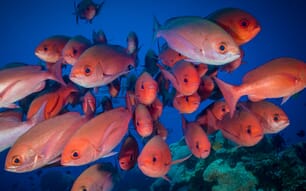The bluefin tuna is one of the world’s great voyagers. It must continuously swim in order to ventilate, generating enough heat to maintain its vital organs and elevate its body temperature above that of the water. Travelling 100km a day at speeds of up to 70km/hour, it is capable of crossing oceans in epic wanderings, but always returning to where it was born for spawning.
But such extraordinary migratory feats have made bluefin tuna habits more elusive for scientists and conservationists at a time when this magnificent fish is under threat from overfishing. Now, however, research has found a way to use satellite remote sensing data to track bluefin in real time, offering hope that a clearer picture of their migratory patterns might lead to better protection of their endangered stocks.
The new model developed by scientists from the European Commission's Joint Research Centre (JRC) – alongside partners from the French Research Institute for Exploitation of the Sea (Ifremer) - allows the potential presence of bluefins to be tracked through daily updated maps. For the first time, it provides an overall view of their preferred feeding and spawning habitats in the Mediterranean Sea, as well as changes over time.
This is crucial for a stock that has seen its numbers collapse over the past half century. The findings, which can also be adapted to other threatened species, could also help combat the notorious misreporting by fishermen who often insist that stocks are healthier than they really are, while catching more than they officially claim. The publicly available satellite imagery could thus prove a valuable tool for monitoring fishing practices and ensuring that the EU lives up to its principles when it comes to building sustainable fisheries.
The model’s innovative approach uses satellite data on the concentration of chlorophyll on the sea surface to identify potential feeding areas, as well as temperature to determine spawning sites.Jean-Noel Druon, who leads the research at the JRC, says the results highlight how bluefin feeding and spawning is concentrated in distinct recurrent locations. “It was a real scientific challenge to derive the bluefin tuna’s potential habitat because it migrates over thousands of kilometres, notably from the North Atlantic for feeding to the Mediterranean Sea for spawning,” he says.
Although spawning grounds generally follow an East-West progression from the eastern Mediterranean in May to the Balearic Islands area in June/July, Druon was still surprised by the high variability. “Some recurrent areas for spawning were unfavourable in a given year and some other areas presented particularly good conditions for reproduction for a specific year, like the one around Sardinia in July 2006," he says.
The research is already being used: real time maps were sent in 2011 during the bluefin tuna fishing season to control authorities of two EU member states in the Mediterranean area, who used it to support their control activity. And habitat maps covering a decade, by two-week periods, have been sent to the European Fisheries Control Agency to potentially improve monitoring. But the project, which began in 2008, is still ongoing, and the model is now being applied to tropical tuna, hake and fin whale.
Although the world's oceans are a shadow of what they once were, and the number of fish swimming the seas is a fraction of what it was a century ago, research like this tuna tracking could help reverse the tide and contribute to a more effective fisheries management, thus helping Europe tackle some of its environmental and food security challenges. “We hope the insight on migration patterns and habitat change that this project brings could not only improve fisheries management but also lead to a rebuilding of stocks,” says Druon.




